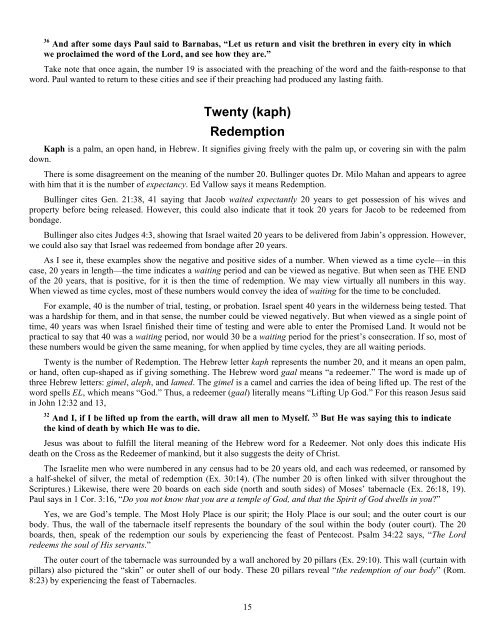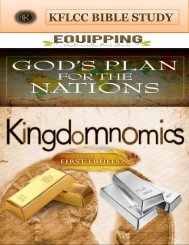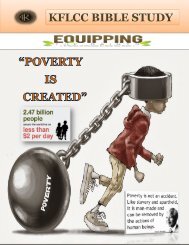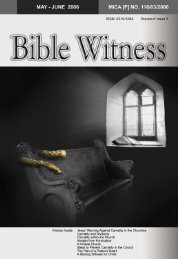You also want an ePaper? Increase the reach of your titles
YUMPU automatically turns print PDFs into web optimized ePapers that Google loves.
36 And after some days Paul said to Barnabas, “Let us return and visit the brethren in every city in which<br />
we proclaimed the word of the Lord, and see how they are.”<br />
Take note that once again, the number 19 is associated with the preaching of the word and the faith-response to that<br />
word. Paul wanted to return to these cities and see if their preaching had produced any lasting faith.<br />
Twenty (kaph)<br />
Redemption<br />
Kaph is a palm, an open hand, in Hebrew. It signifies giving freely with the palm up, or covering sin with the palm<br />
down.<br />
There is some disagreement on the meaning of the number 20. Bullinger quotes Dr. Milo Mahan and appears to agree<br />
with him that it is the number of expectancy. Ed Vallow says it means Redemption.<br />
Bullinger cites Gen. 21:38, 41 saying that Jacob waited expectantly 20 years to get possession of his wives and<br />
property before being released. However, this could also indicate that it took 20 years for Jacob to be redeemed from<br />
bondage.<br />
Bullinger also cites Judges 4:3, showing that Israel waited 20 years to be delivered from Jabin’s oppression. However,<br />
we could also say that Israel was redeemed from bondage after 20 years.<br />
As I see it, these examples show the negative and positive sides of a number. When viewed as a time cycle—in this<br />
case, 20 years in length—the time indicates a waiting period and can be viewed as negative. But when seen as THE END<br />
of the 20 years, that is positive, for it is then the time of redemption. We may view virtually all numbers in this way.<br />
When viewed as time cycles, most of these numbers would convey the idea of waiting for the time to be concluded.<br />
For example, 40 is the number of trial, testing, or probation. Israel spent 40 years in the wilderness being tested. That<br />
was a hardship for them, and in that sense, the number could be viewed negatively. But when viewed as a single point of<br />
time, 40 years was when Israel finished their time of testing and were able to enter the Promised Land. It would not be<br />
practical to say that 40 was a waiting period, nor would 30 be a waiting period for the priest’s consecration. If so, most of<br />
these numbers would be given the same meaning, for when applied by time cycles, they are all waiting periods.<br />
Twenty is the number of Redemption. The Hebrew letter kaph represents the number 20, and it means an open palm,<br />
or hand, often cup-shaped as if giving something. The Hebrew word gaal means “a redeemer.” The word is made up of<br />
three Hebrew letters: gimel, aleph, and lamed. The gimel is a camel and carries the idea of being lifted up. The rest of the<br />
word spells EL, which means “God.” Thus, a redeemer (gaal) literally means “Lifting Up God.” For this reason Jesus said<br />
in John 12:32 and 13,<br />
32 And I, if I be lifted up from the earth, will draw all men to Myself. 33 But He was saying this to indicate<br />
the kind of death by which He was to die.<br />
Jesus was about to fulfill the literal meaning of the Hebrew word for a Redeemer. Not only does this indicate His<br />
death on the Cross as the Redeemer of mankind, but it also suggests the deity of Christ.<br />
The Israelite men who were numbered in any census had to be 20 years old, and each was redeemed, or ransomed by<br />
a half-shekel of silver, the metal of redemption (Ex. 30:14). (The number 20 is often linked with silver throughout the<br />
Scriptures.) Likewise, there were 20 boards on each side (north and south sides) of Moses’ tabernacle (Ex. 26:18, 19).<br />
Paul says in 1 Cor. 3:16, “Do you not know that you are a temple of God, and that the Spirit of God dwells in you?”<br />
Yes, we are God’s temple. The Most Holy Place is our spirit; the Holy Place is our soul; and the outer court is our<br />
body. Thus, the wall of the tabernacle itself represents the boundary of the soul within the body (outer court). The 20<br />
boards, then, speak of the redemption our souls by experiencing the feast of Pentecost. Psalm 34:22 says, “The Lord<br />
redeems the soul of His servants.”<br />
The outer court of the tabernacle was surrounded by a wall anchored by 20 pillars (Ex. 29:10). This wall (curtain with<br />
pillars) also pictured the “skin” or outer shell of our body. These 20 pillars reveal “the redemption of our body” (Rom.<br />
8:23) by experiencing the feast of Tabernacles.<br />
15

















